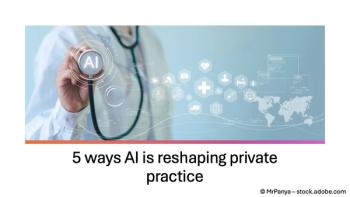
You've Got Mail!
How to manage e-mail from patients
If you're thinking about picking up the phone and calling Daniel Griffin, MD, reconsider. The internist with Alpenglow Medical in Ft. Collins, Colo., has so wholeheartedly embraced e-mail that he encourages his patients to contact him via the Internet.
According to a poll released in July 2000 by LaurusHealth.com, 46 percent of consumers would like to e-mail their doctors. But there's a catch: Only 3 percent of patients actually do. That might be because so many physicians don't yet encourage or accept patient e-mails.
Barry Hibb, research director of the Gartner Group, a consulting firm headquartered in Stamford, Conn., doesn't think that e-mailing between physicians and patients will take off for another year or so. "Until it can be proven that e-mailing saves time and money and improves care, doctors won't be convinced," he says. "In addition, there is no malpractice law governing e-mail, so what happens if a doctor gives advice on the Web and it goes bad?"
Do it now or do it later?
Still, there is evidence that many physicians are willing to jump online faster. The 1999 Internet Survey of Medicine by online healthcare giant Healtheon, indicates that 33 percent of physicians were using e-mail to communicate with patients - up 200 percent from the beginning of that year.
Concerns about patient privacy remain a major sticking point, but Rosemarie Nelson, a consultant in Syracuse, N.Y., believes consumers will be the impetus behind increasing popularity of physician-patient e-mail.
That's how it started with William Jordan, a medical oncologist and president of the Texas Cancer Center. His patients found his e-mail address, and the rest is history.
"Patients have become consumers and partners in their healthcare, and e-mail has become a great tool to support that," he says. He answers about 25 e-mails weekly and tries to respond within 12 hours.
Jordan's patients communicate with him about their health status and responses to therapy - daily updates on pain or side effects from a prescription - allowing him to make adjust-ments via e-mail, request validation of medical literature, and schedule appointments.
But tell David Donnell, an internist in Dallas, that it's patients who get the e-mail rolling, and he'll disagree. Four years ago, he started giving his patients his e-mail address, accompanied by rules on how to best use e-mail - for prescription refills, medical advice, or help in determining whether to see a specialist.
Pros and cons
Like many of his cohorts, Donnell praises e-mail for its efficiency; it eliminates phone tag, allows him to answer e-mails when he has free time, and provides easy documentation of the correspondence in an electronic medical record. He can also pick up or respond to e-mails when he is out of the office. "Patients are more efficient about what they say in an e-mail, which also eliminates the time-consuming dialogue of a phone call," adds Griffin.
Donnell warns colleagues to be aware of the inappropriate use of e-mail, such as a request for a second opinion from patients they have never met. Other physicians are concerned that their server will shut down and make it impossible to receive e-mails on a timely basis, or that e-mails will go unanswered in their absence.
For that reason, some physicians have their nurses triage e-mails. In fact, most physicians treat e-mails as they would phone calls, documenting the contents of every correspondence. They are also careful not to diagnose over the Internet and to avoid time-sensitive issues, instead focusing on non-urgent care and clarification of advice offered during an office visit.
For instance, one of Donnell's patients e-mailed him about an ineffective allergy medication; Donnell changed the prescription. On the other hand, another patient explained via e-mail that she had been losing weight; Donnell recommended an office visit.
As of yet, none of these physicians is complaining about e-mails escalating beyond a level they can handle. "But it could potentially get out of hand," Jordan says. And if it does, he plans to develop a set of guidelines to help patients know what kinds of questions are acceptable for e-mail.
Griffin has already put together a set of standards and expectations for patients who e-mail. They outline:
- turnaround times - usually within two business days;
- when to use e-mail - preferably for non-urgent matters, medical questions, prescription refills, and appointment scheduling; and
- privacy - which he says he can't guarantee.
While no standards are yet in place to assure security, the Health Insurance Portability and Accountability Act (HIPAA) is putting pressure on the healthcare industry to formulate some consistent measures for authenticating or confirming physician-patient e-mail exchanges.
Michael Nancollas, an orthopedic surgeon in Syracuse, N.Y., makes e-mail available to all of his patients, although only about 5 percent use it. He is not worried about improper delivery of his e-mails nor does he have concerns about privacy. "But maybe that's the nature of my practice - no life or death situations," he says.
On the other hand, Jordan notifies patients when he receives e-mails and, in turn, receives alerts that his e-mails have been read; if there is any doubt, he has his nurse call the patient.
Despite their increasing facility in handling e-mails, physicians walk a fine line between the demands of patients and payers. "We are caught in a struggle with patients and consumers demanding information and insurance companies issuing warnings about non-coverage," says Jim Gilmore, a cosmetic and plastic surgeon in Dallas.
Getting paid
While reimbursing physicians for e-mail is rare, First Health, an Illinois-based PPO network, is soon to become an anomaly. It is planning to pay its physicians on a per-episode basis by year's end, says Mary Anne Carpenter, executive vice president for service products. The PPO is currently piloting e-mail exchange with its diabetes and hypertension patients enrolled in its care support program. "E-mail will allow these chronic patients to relay their blood sugar levels or blood pressure without feeling like they are bothering their physicians," Carpenter adds. "We will offer both templates for e-mails, as well as encourage free-form conversation."
Donnell says he has never considered charging his patients for e-mail. "It is such a cost-saver in terms of efficiency that I am happy to pick up the cost," he adds.
Joyce Flory, a Chicago-based business and healthcare consultant, predicts that e-mail is just an appetizer for patients hungry for access and information. "Patients don't just want e-mail; they want a virtual electronic relationship with their physicians that mirrors and reinforces the relationship they maintain in the real world, such as online consults and two-way videoconferencing," Flory says.
That day isn't here yet, but physicians can prepare for it by familiarizing themselves with the pros and cons, the benefits and liabilities, of patient-physician e-mail.
Mari Edlin can be reached at
This article originally appeared in the May/June 2001 issue of Physicians Practice.
Newsletter
Optimize your practice with the Physicians Practice newsletter, offering management pearls, leadership tips, and business strategies tailored for practice administrators and physicians of any specialty.








